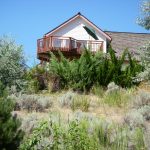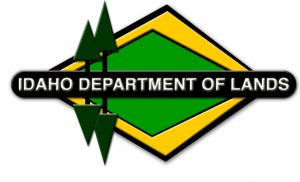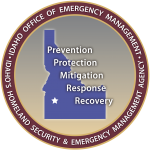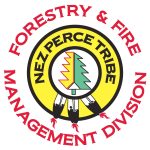
Fire Resistant Homes
Building Materials
Principles & Practices
WUI Culture
One of the most important responsibilities a WUI homeowner has is to reduce your home’s vulnerability to wildfire ignition.
Building Codes for New Construction
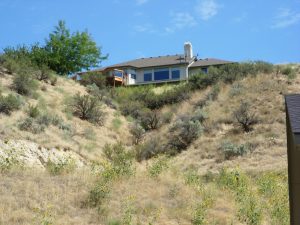
Draws act like chimneys and carry fire up slopes. If possible, locate new construction AWAY from the edges of draws and slopes.
If you have not started constructing your new WUI home, an important consideration available to you that others do not have, the placement of your home and other structures on the landscape.
Wildfires burn more rapidly up hills and draws, so try to place all structures on flat ground. If this is not possible, set building back 100 to 200-feet from the edges of slopes and avoid cantilevering any part of a structure over the edges.
Many communities in Idaho have adopted all or part of the International Wildland-Urban Interface Code (2006). These codes set standards for new construction and can include:
- Ignition resistant building materials.
- Ignition resistant building techniques.
- Driveway access for fire apparatus.
- Vegetation plans for new residences and subdivisions that provide defensible space.
- Sprinkler systems on structures over 5000 sq. ft.
- Proper address labels for emergency response.
- Other restrictions on outdoor burning, outside storage, etc.
For ordinances and building codes for your area, contact your local Idaho city or county Planning and Zoning Office.
Retrofitting Existing Homes and Structures
Replacing a flammable roof or the siding of an existing structure is usually the most expensive components of a retrofit, but will be well worth the price if your home is threatened by wildfire.
Roofs
Homes without fire-resistant roofs are up to 21 times more likely to be destroyed by wildfire. Though no building material is fireproof, using fire-rated materials and approved structural assemblies can significantly reduce the time it takes a fire to ignite a roof and spread into the underlying structure.
Roofing materials are rated for flammability and categorized as Class A, B, or C or unrated.
- Class A roofs are able to withstand severe exposure to fire and should be the choice for anyone living in wildland/urban interface areas. Materials include asphalt fiberglass composition shingles, concrete or clay tiles, brick, slate, fiber-cement products, and metal.
- Class B roofs are able to withstand a moderate exposure to fire and include fire retardant pressure-treated shakes and shingles.
- Class C roofs are able to withstand light exposure to fire and include plywood and particleboard.
- Unrated roofs, such as non-fire retardant treated wood shakes or shingles, are the most vulnerable, and in many cases, offer almost certain ignition of your home.

Home protected by a fire safe roof.
Some materials have a “by assembly” fire rating, meaning that additional materials must be used between the roof covering and the roof sheathing in order to attain that fire rating. Examples of roof coverings with a “by assembly” fire rating include aluminum, some fire-retardant wood shake products, and recycled plastic and rubber products.
Determine your current roof’s flammability rating and replace existing roofs once they have reached the end of their service life with one with a suitable flammability rating for your area. If you are not sure, or want to confirm your roof type, schedule a professional roof inspection.
Eaves, soffits, and vents
Roof eaves extending beyond exterior walls are also prone to flames, so limit their length and box in, or enclose, soffits with fire-resistant materials. All eaves and soffits should be boxed or enclosed with metal screens to reduce the size of the openings. Small openings such as attic and dryer vents can provide a place for embers to enter your home; screen these and other small openings with 1/8” wire mesh.
Windows
Exposure to the heat of a wildfire can cause glass on exterior walls to fracture and collapse, allowing firebrands to enter structures. Choose double-paned windows made with tempered glass when installing or replacing windows – they are the most fire-resistant. Embers can burn through plastic screens and should be replaced metal screening to prevent embers from entering your home.
Chimneys
Early fall is a critical time for wildfires starting from the chimney sparks. Make sure chimneys have approved spark arresters and are inspected and cleaned at least once a year. It is also a good idea to keep a supply of a chimney fire extinguishing product on hand to extinguish chimney fires.
Decks and siding
Ideally, decks and siding should be made of fire-resistant materials.
Siding and decking materials that resist heat and flames include cement, plaster, stucco, masonry (such as stone brick or blocks) and fiber-cement products.
If your home is sided with a combustible material like wood, you will want to be extra vigilant about finding and repairing any openings could allow harbor to enter the substructure.
If it’s attached to a structure, it’s part of the structure
Combustible objects such as decks and fences can act like a fuse and lead flames directly to your house. Enclose the area under decks, stairways, and overhangs with 1/8-inch wire mesh to prevent embers from entering. Replace flammable fencing with nonflammable materials; if not possible, open gates to break-up connecting fuels in the event of a blaze.

Contact Us
Ivy Dickinson, Executive Director
ivy@idahofirewise.org
phone/fax: 208-310-7472
toll free: 888-285-5889

